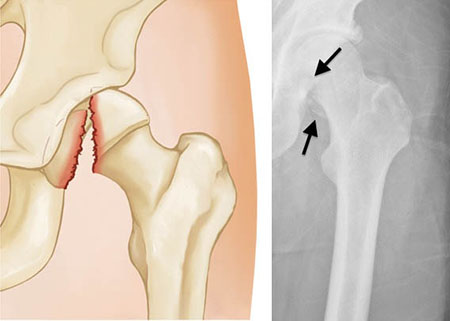A nurse is caring for an older adult client who had a femoral head fracture 24 hours ago and is in skin traction. The client reports shortness of breath and dyspnea. The nurse should suspect that the client has developed which of the following complications?
Pneumothorax
Pneumonia
Airway obstruction
Fat embolism
The Correct Answer is D
Choice A reason:
Pneumothorax, a collapsed lung, can indeed cause shortness of breath and dyspnea. However, it is typically associated with a sudden onset of these symptoms following a chest injury or spontaneously in the case of a ruptured air blister. In the context of a femoral head fracture, pneumothorax is less likely unless there was additional trauma to the chest area.
Choice B reason:
Pneumonia is an infection of the lungs that leads to inflammation of the air sacs, causing them to fill with fluid or pus. Symptoms include cough with phlegm, fever, chills, and difficulty breathing. While pneumonia could cause dyspnea, it usually develops due to an infectious process rather than directly from a femoral head fracture.
Choice C reason:
Airway obstruction involves a blockage that prevents air from passing freely to the lungs. It can be caused by foreign objects, swelling due to allergic reactions, or other medical conditions. The symptoms of airway obstruction include difficulty breathing, wheezing, and potential changes in skin color. However, airway obstruction is not commonly a direct complication of a femoral head fracture.
Choice D reason:
Fat embolism syndrome is a serious condition that occurs when fat globules enter the bloodstream and lodge within the pulmonary vasculature, leading to respiratory distress. It is a known complication following long bone fractures, such as the femur, and presents with symptoms like shortness of breath, hypoxemia, and neurological manifestations. Given the recent femoral head fracture and the symptoms reported, fat embolism syndrome is the most likely diagnosis.

Nursing Test Bank
Naxlex Comprehensive Predictor Exams
Related Questions
Correct Answer is A
Explanation
Choice A: Monitor the client for hypoglycemia
When a nurse administers an incorrect insulin dose, the immediate concern is the risk of hypoglycemia, especially since the insulin dose given was for a higher blood glucose level than the actual reading. Hypoglycemia can occur when blood glucose levels drop below 70 mg/dL. Symptoms of hypoglycemia include shakiness, sweating, confusion, and in severe cases, loss of consciousness. Monitoring the client for hypoglycemia allows the nurse to detect and treat it promptly, ensuring the client’s safety.
Choice B: Complete an incident report
While completing an incident report is important for documenting the medication error and preventing future occurrences, it is not the immediate priority. The nurse’s first responsibility is to ensure the client’s safety by addressing the potential hypoglycemia. Once the client’s condition is stable, the nurse can then complete the incident report.
Choice C: Give the client 15 to 20 g of carbohydrate
Administering 15 to 20 grams of carbohydrate is a treatment for hypoglycemia. However, this action should only be taken if the client is actually experiencing hypoglycemia. The nurse should first monitor the client’s blood glucose levels to confirm hypoglycemia before administering carbohydrates.
Choice D: Notify the nurse manager
Notifying the nurse manager is important for accountability and to ensure that appropriate follow-up actions are taken. However, it is not the immediate priority. The nurse should first monitor the client for hypoglycemia and address any immediate health concerns before notifying the nurse manager.
Correct Answer is C
Explanation
Choice A reason:
Using chemotherapy instead of radiation may not be a viable option as the treatment plan is based on the type and stage of cancer. Chemotherapy can also affect fertility, so it is not a direct solution to the concern of infertility.
Choice B reason:
Fertility medications during treatment might help preserve fertility, but they do not address the direct impact of radiation on reproductive organs. Additionally, the use of such medications should be discussed with an oncologist and a fertility specialist.
Choice C reason:
Radiation shielding techniques involve using protective shields to limit radiation exposure to the reproductive organs. This can help reduce the risk of infertility caused by radiation, especially when the pelvic area is involved in the treatment.
Choice D reason:
Surgical interventions to remove the cancer may be part of the treatment plan, but they do not directly address the concern of radiation-induced infertility. Surgery can also result in infertility, depending on the organs involved and the extent of the procedure.
Whether you are a student looking to ace your exams or a practicing nurse seeking to enhance your expertise , our nursing education contents will empower you with the confidence and competence to make a difference in the lives of patients and become a respected leader in the healthcare field.
Visit Naxlex, invest in your future and unlock endless possibilities with our unparalleled nursing education contents today
Report Wrong Answer on the Current Question
Do you disagree with the answer? If yes, what is your expected answer? Explain.
Kindly be descriptive with the issue you are facing.
